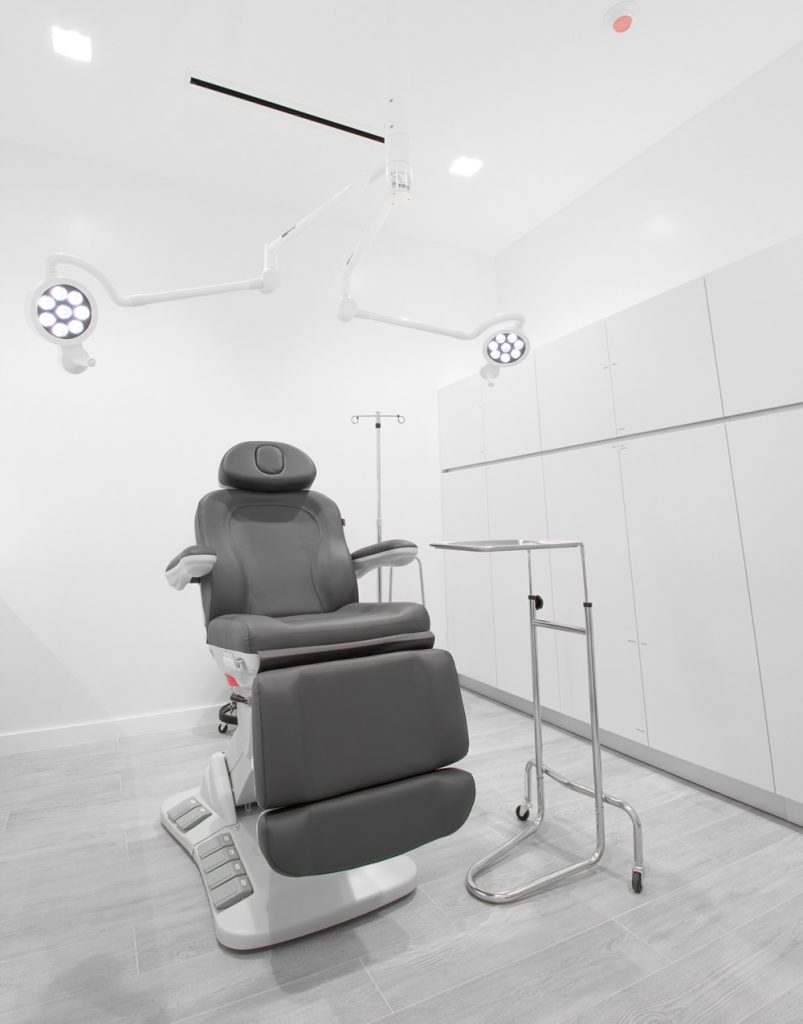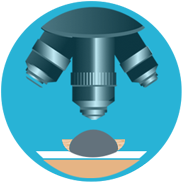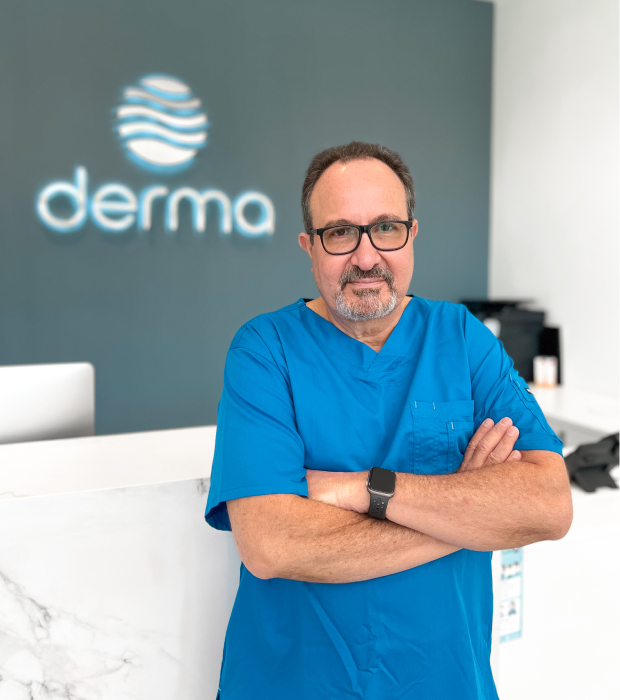Mohs Surgery
Many treatments require surgical excision of skin cancer, followed by days of waiting for lab results. In contrast, Mohs surgery allows patients to leave within hours, cancer-free.
Mohs surgery is the most advanced and precise skin cancer treatment, with the highest cure rates of up to 99%! It removes tumors while preserving healthy tissue, yielding excellent cosmetic results and minimal recurrence. It’s the gold standard for basal cell and squamous cell carcinomas.

How Mohs Surgery Works
Mohs surgery is a special way to take care of skin cancer spots. In this procedure, the doctor gently takes off thin layers of skin, bit by bit, and looks at each layer carefully under a microscope to see if any cancer is still there. They keep doing this until only healthy, cancer-free skin is left behind.

1
The visible tumor and a thin layer of surrounding skin are removed.

2
The tissue is examined under a microscope to see if any cancer cells remain at any of the edges.

3
If any cancer cells remain, additional skin is removed and examined under the microscope.

4
This process continues until no more cancer cells are found at the edges.
About Dr. Weiss
Dr. Eduardo Weiss is a highly accomplished dermatologist with an extensive background in medical education and clinical practice. He graduated with honors from the Universidad Central de Venezuela School of Medicine in 1982 and further honed his expertise through advanced training at the University of Miami, where he served as the chief resident.
Dr. Weiss is a double board-certified dermatologist by the American Board of Dermatology in Dermatology and Micrographic Dermatologic Surgery, and his dedication to his field is evident, having performed over 2,000 Mohs surgeries annually for the past 20 years.

Advantages of Mohs Surgery
Mohs surgery stands out as a highly effective choice for skin cancer treatment, boasting an impressive 99% cure rate for primary tumors. Its same-day results bring immediate peace of mind, while its minimally invasive approach ensures minimal scarring and a relatively straightforward recovery process, making it the preferred option for many patients.
Highest Cure Rates
Success rate of 99 percent for primary tumors.
Cost-Effective And Efficient
Single-visit outpatient surgery using local anesthesia.
No Travel Time
Procedure completed on island, no need to go overseas anymore.
Same-Day Peace of Mind
No waiting weeks for biopsy results — lab work is done on-site so you can leave the office cancer-free.
Smaller Scars
Minimally invasive (spares healthy tissue). Best cosmetic results of any skin cancer treatment.
Easy Recovery
Most post-treatment wounds heal on their own or require only minimal reconstructive surgery.
What Our Clients Say
Arrive with skin cancer. Leave without it.
Contact the team at Derma today for a consultation to see if Mohs is the right treatment plan for you.

Frequently Asked Questions
- Pre-Procedure
- During Procedure
- After Procedure
- Recovery
As the surgery is conducted using local anesthesia, it’s advisable to have a regular, nutritious breakfast and/or lunch on the day of the procedure. The only exception would be if you have scheduled your reconstruction with another doctor following Mohs surgery; in that case, please adhere to the specific guidance provided by the other physician’s office.
As alcohol thins the blood and therefore can promote unnecessary bleeding we recommend that you avoid consuming alcoholic beverages a minimum of 24 hours before and after your surgery.
Before your surgery, it’s important to ensure you’ve taken your daily prescription medications, especially blood pressure medications. If you usually take antibiotics before dental or other surgical procedures due to artificial joints or heart valves, kindly let us know when you arrive for your appointment, as we may administer antibiotics prior to surgery.
Patients who have been prescribed blood thinners by a physician should continue following their prescribed regimen. While stopping these medications may reduce surgical risks such as bleeding and bruising, doing so can increase the risk of more serious events like stroke, heart attacks, or blood clots. If you choose to discontinue a blood thinner on your own, please coordinate a plan for resuming the medication after your surgery is complete.
For patients on warfarin (Coumadin), it’s essential to have your INR checked one week before the surgery. If your INR level is greater than 3.0, kindly inform us. Your safety and well-being are our top priorities.
We strongly advise arranging for a companion to transport you to and from our office on the day of your surgery. This individual is welcome to stay with you during the waiting periods between procedure stages. Furthermore, if someone other than yourself is responsible for post-operative wound care, our nurse can provide them with clear instructions and a demonstration of the proper wound care procedures. Your safety and comfort are our top priorities.
The duration of Mohs surgery can vary, depending on the size and depth of the skin cancer. Each stage of tissue removal and microscopic examination can take about 1 hour. Most patients can expect the procedure to last anywhere from 1.5 hours to 3 hours, depending on the number of stages required for their surgery. We recommend planning to spend about 3 hours at the office, from the time your surgery starts.
Yes, Mohs surgery is performed under local anesthesia, so you will be awake throughout. You may feel some pressure or movement, but you should not feel anything sharp. We will ensure you are as comfortable as possible throughout the process.
After each layer of tissue is removed, it is frozen and examined under a microscope to check for clear borders. During this analysis, you’ll wait comfortably in the room.
No, for sterile reasons, they may not be permitted in the procedure room during tissue removal. For patient privacy we ask that family members not wait in the waiting area.
Yes, most patients will have either absorbable stitches, a bandage, or both. The type of wound closure depends on the size and location of the surgical site. We will discuss the closure method and provide detailed care instructions before you leave.
Some discomfort, swelling, or tightness around the surgical site is normal. Most patients find relief with over-the-counter pain medication such as acetaminophen (Tylenol/Panadol). Avoid aspirin or ibuprofen unless prescribed, as these can increase the risk of bleeding.
Yes, we will schedule a wound check appointment to review your healing and two-three weeks later to remove stitches if necessary.
We recommend limiting strenuous activity, exercise, sweating, or heavy lifting for 2 weeks following surgery. We may give you specific guidance based on your surgical site and overall healing.
Healing times vary based on the size and location of the wound, but most patients heal within 4 to 6 weeks. Facial wounds may take longer to fully mature and fade. We will monitor your progress during follow-up visits.
All surgical procedures result in some scarring. However, Mohs surgery minimizes the amount of healthy tissue removed, which typically leads to smaller scars. We make every effort to achieve the best cosmetic result and may recommend scar treatments as needed.
Redness, increased swelling, warmth, pus, or a fever may indicate an infection. If you notice any of these symptoms, please contact our office promptly so we can address your concerns.
Many patients are able to return to work the next day, depending on the extent of the surgery and their comfort level. If your job is physically demanding or you’re concerned about visibility of the bandage, you may wish to take additional time off.
Get In Touch With Us
Need assistance? We’re here for you. Contact us today.
LOCATION
The Grove, 1358 West Bay road, Seven Mile Beach, Grand Cayman , Cayman Islands
CALL US
EMAIL
BUSINESS HOURS
Mon-Fri 9am to 5pm, Sat 9am to 12pm

